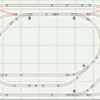Howdy Folks,
This is the first time that I am posting to these forums. I've been a long time reader, but I had been out of model railroading for quite some time. My eleven year old decided that he wanted a train setup again. We picked up a N Scale, but I have so much money invested in O Gauge (mostly MTH locomotives) I decided to purchase the DCS setup and finish what I had originally intended. I picked up the DCS O Gauge Companion, but wanted to seek clarification on a couple items.
The initial layout will roughly be 4' by about 16' foot and have 6 remotely/digitally controlled switch tracks (MTH). I am using 14 gauge wire for track power and 18 gauge to control the switches. For power I am using a Z1000 brick. I will be powering the TIU with a Z750 brick. I am intending to use the Accessory power of the Z1000 brick to run the switches. My first questions have to do with what I just mentioned. I know that when you are using separate transformers that they need to be in phase and that you need to connect the common grounds. Am I right in thinking that when you are using the accessory power that I do not need to connect common? and that I don't need to worry about phase? Should I have an inline fuse, or is the built-in resettable fuse in the transformer cover both?
The last time I had set up a layout, which was larger than the one I am planning, I did not configure the layout into blocks/districts and only used 1 transformer (Z1000) which powered the track and the switches. I used additional lock-ons to deliver power. This time around I am planning on running 2 locomotives, maybe 3. They will mostly be hauling freight cars (6 or so each, unlighted) and 3 lighted passenger cars at any given time. It seems that the Z1000 brick should be able to handle this without any issues. Any thoughts?
When it comes to electricity and wiring I know only enough to be dangerous to myself. :-) I am a tad intimidated by reading descriptions and I am more of a visual person. Am I correct in stating that if I were to break the track into districts that I can use the MTH insulated tracks and remove the center jumper? I would then need to make sure that the transformers are phased and that I would use a terminal block to connect the common (black) wires together. Then just use lock-ons to deliver power as necessary. I also would like to have a rail yard or siding to keep unused trains. If the siding has power and the train is sitting there, the chrono clock will be running, right? I would then need to wire a toggle switch to remove power? Any good pictures of accomplishing this task?
Sorry for the long winded first post. :-)
All the Best!
~MattS








